You are using an out of date browser. It may not display this or other websites correctly.
You should upgrade or use an alternative browser.
You should upgrade or use an alternative browser.
Smith and Wesson internal lock
- Thread starter ATN082268
- Start date
I am a recluse who does not hang around people in bars so I have heard none of those stories about the internal locks. Nevertheless, I resent S&W including a part whose purpose was entirely political and have no interest in buying one of their revolvers with the unnecessary part as long as I can still find the older models that do not have it. Additionally, having purchased a Colt XSE Combat Commander with the 80's firing pin system (another unnecessary part), a few years ago, and having experienced what a pain it is to reassemble after cleaning, any additional 1911 I buy will be of the 70's configuration.The S&W "lock" has had more lies told about it than about anything I know. Millions of people have NOT been killed because the lock jammed the gun. Tens of thousands of corpses are NOT littering the streets because their defense S&W's failed. Millions of guns have NOT been shipped back to S&W because the locks broke, jammed the guns, or caused the guns to blow up.
The fact is that a small number of lunatics decided that S&W had "betrayed" them and took revenge by spreading lies on the internet. I have heard all the stories, from blown up guns littering police ranges to S&W paying billions of dollars in compensation for "slaughtering" its customers. A few of the "concerned citizens" reportedly tried to blackmail S&W, demanding millions of dollars to "keep quiet" about S&W's "murder guns." The threat of legal action stopped that pretty quickly.
Sorry, but I own and fire S&W's with the "lock" and the last time I checked I am still alive.
PolarFBear
New member
I have to "vote" with my dollar and will avoid a S&W with a lock. Yes, I am a "deplorable". The so called sell-out in the Clinton era still rankles me. Plus, the esthetics of the compromise are just that, a compromise of engineering. I have several non-lock models. Would like a new Mt. Gun but will settle for a Ruger Blackhawk.
Actually, people in bars can be interesting, and often amusing.
Obviously, everyone makes his or her own decisions in any purchase. If one chooses to avoid brand X based on advice from the tooth fairy, that is a valid reason for that person. But one need have looked no further than this and some other forums at the peak of the "hate S&W" fanaticism to find weird posts. I have long believed that the people behind the campaign were part of the anti-gun gang, eager to put all gun makers out of business, either by law or by encouraging law suits based on fake "safety" concerns and phony incidents.
Jim
Obviously, everyone makes his or her own decisions in any purchase. If one chooses to avoid brand X based on advice from the tooth fairy, that is a valid reason for that person. But one need have looked no further than this and some other forums at the peak of the "hate S&W" fanaticism to find weird posts. I have long believed that the people behind the campaign were part of the anti-gun gang, eager to put all gun makers out of business, either by law or by encouraging law suits based on fake "safety" concerns and phony incidents.
Jim
S&W's don't have a transfer bar.
I got the terminology wrong. I did a google.
It is the first piece to fall out when you remove the side plate. I know, the poster knows the terminology. he can elaborate if he wishes.
I like the older S&W revolvers too....but there is really nothing wrong with models like the new 627 ( 8 shot .357 mag ) that have the internal frame lock.
I bought a pair of the Performance Center 627's about a year ago...one in a 2 5/8" and one in a 5"....( appearance is very different, they are full of MIM parts --- but they are well balanced with pretty good triggers in them stock right out of the box. I've probably put 5,000 rds thru each of the new 627's...with no issues ( they are N frames )..not K frames like the model 19../ ....legacies of the older model 27's ...
I bought a pair of the Performance Center 627's about a year ago...one in a 2 5/8" and one in a 5"....( appearance is very different, they are full of MIM parts --- but they are well balanced with pretty good triggers in them stock right out of the box. I've probably put 5,000 rds thru each of the new 627's...with no issues ( they are N frames )..not K frames like the model 19../ ....legacies of the older model 27's ...
Driftwood Johnson
New member
I got the terminology wrong. I did a google.
It is the first piece to fall out when you remove the side plate.
Howdy
I suspect what you are talking about is the Hammer Block. It works the exact opposite of a Transfer Bar. Smith and Wesson has never used Transfer Bars.
Transfer bars transfer the impact of the hammer to a frame mounted firing pin. They are designed so they only rise up to position when the trigger is pulled.
The current version of the S&W Hammer Block has been around for a long time, since about 1944 when an accident happened on ship board. The Hammer Block will prevent the firing pin from striking a primer even if the gun is dropped from a great height and lands on the hammer spur. Prior to this design there were at least two earlier designs for Hammer Blocks in S&W double action revolvers.
The slanted piece in this photo of a Model 14-3 is the Hammer Block. Yes, they can be tricky to get back in properly. Some 'gunsmiths' have even been known to leave them out, thinking they cause undo friction in the action. Try taking your Smith apart a few more times and you will get the hang of putting the hammer block back in. Line it up just as you see in this photo, with the pin in the Rebound Slide at the bottom of the slot in the Hammer Block, and the top of the Hammer Block between the hammer and the frame.
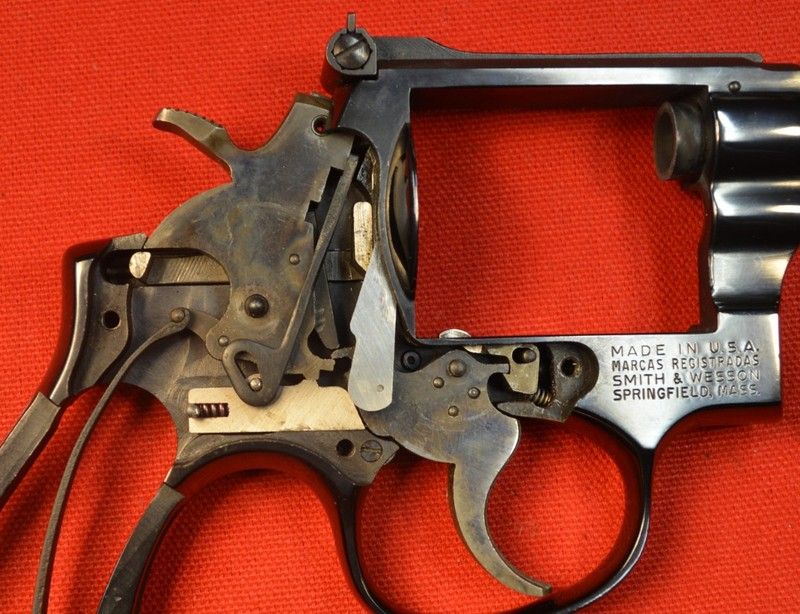
Or, if you prefer, here is a photo of the Hammer Block in the lockwork of a more modern Smith made with yukky MIM parts.
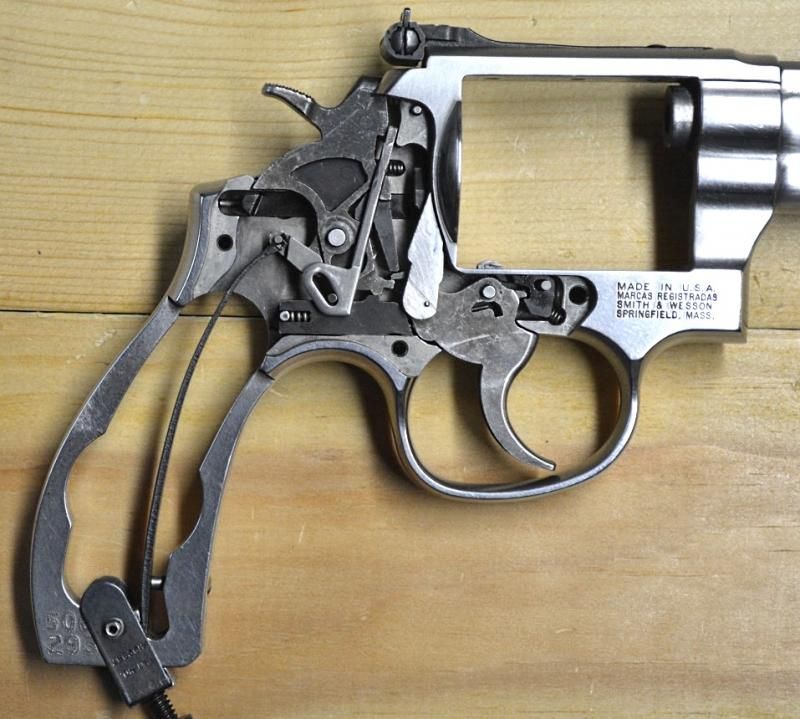
Last edited:
yea, that is the part. I did not try and figure out the function. OK, to be honest, I did try and did not get what it was doing. I guessed and got it backwards. Like you said, assembly is not a big deal, just not so easy either. It seemed like a bit hokey. Maybe it was some clever engineer figured a way to avoid a complete redesign.
I am not a fanboy of any one brand. I own a variety of revolvers. I think all brands have some plus and minus and my own opinions are just that. I had an old worn out colt DA revolver that tainted my view on the lock up. That does not make colt bad. I know its just me and probably that one gun. I like Ruger, but; I understand why some might prefer another. I like my new smith and I have a few great older examples.
I am not a fanboy of any one brand. I own a variety of revolvers. I think all brands have some plus and minus and my own opinions are just that. I had an old worn out colt DA revolver that tainted my view on the lock up. That does not make colt bad. I know its just me and probably that one gun. I like Ruger, but; I understand why some might prefer another. I like my new smith and I have a few great older examples.
BlackLabsMatter
New member
(edit: wrong thread)
I've never really understood the apprehension toward disabling extra locks/safeties.
People will say that it opens one up to legal liabilities. When pressed for an example of it ever happening, they have nothing.
I believe it was started by Ma's Ayoob. He said not to do it since he knew of a man who was convicted of negligent homicide who removed a mag disconnect from a Hi Power.
What he glossed over was the fact the man he killed was intentionally killed was his friend who meant no harm, it was dark and the man opened fire without identifying the target.
And the mag disconnect had nothing to do with it, negligent homicide was the proper and just ruling.
Plenty of other guns have safeties that don't belong(like Marlin). Disabling them is simple.
I've never really understood the apprehension toward disabling extra locks/safeties.
People will say that it opens one up to legal liabilities. When pressed for an example of it ever happening, they have nothing.
I believe it was started by Ma's Ayoob. He said not to do it since he knew of a man who was convicted of negligent homicide who removed a mag disconnect from a Hi Power.
What he glossed over was the fact the man he killed was intentionally killed was his friend who meant no harm, it was dark and the man opened fire without identifying the target.
And the mag disconnect had nothing to do with it, negligent homicide was the proper and just ruling.
Plenty of other guns have safeties that don't belong(like Marlin). Disabling them is simple.
Last edited:
Driftwood Johnson
New member
I've never really understood the apprehension toward disabling extra locks/safeties.
Try telling that to the parents of the sailor who was killed in 1944 when a Victory Model discharged when it hit the deck of a warship.
I think a little lesson on the history of the Smith and Wesson Hammer Block is in order.
It had long been known that the old single action revolvers from the 19th Century were not safe to carry fully loaded with a live round under the hammer. A strong blow to the hammer, such as might happen if the gun fell to the ground and landed on its hammer spur, could shear off the so called 'safety cock' notch, or break the sear, causing the firing pin to strike a primer with enough force to fire a cartridge. So anybody who is familiar with single action revolvers with a Colt type lockwork knows to only load five rounds and keep the hammer down on an empty chamber. We could ask Mr Ruger about that if he were still with us.
So when double action revolvers started to become commonplace at the end of the 19th Century, many of them had rebounding hammers, to prevent accidental discharge. Iver Johnson was among the first, IJ invented the Transfer Bar, and their 'Hammer the Hammer' advertising campaign became well known for promoting how safe their revolvers were.
Here is the lockwork on a Smith & Wesson 38 M&P that was made around 1908. Notice the hump on top of the rebound slide and how it is wedging the hammer back from the frame. This feature is still incorporated in all S&W revolvers today. Now take a look at the red line I drew across the hammer. If enough force is applied to the hammer spur, that is the place where the hammer will break. Once it breaks, the hammer will rotate forward and the firing pin will strike the primer of a round under the hammer. The other failure mode is the stud the hammer rotates on may shear off, with the same result. Granted, it will take a great deal of force for either of these scenarios to happen, but they did happen.
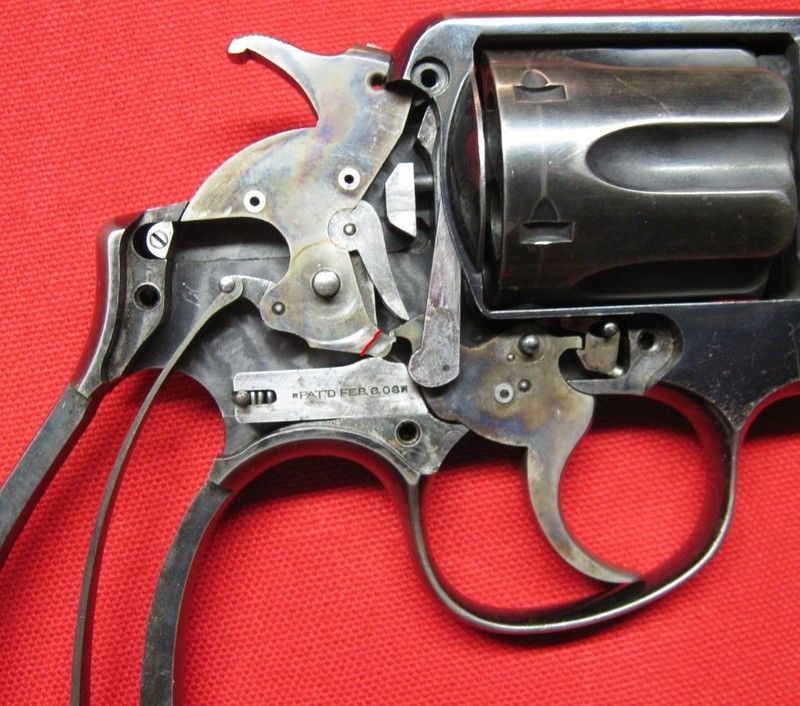
Flash forward a few years and S&W thought it would be a good idea to add a hammer block to their revolvers, to prevent a discharge in case the hammer got struck. This was a long time ago, long before our current litigious society that sues at the drop of a hat. S&W simply thought an extra safety device was necessary to safeguard their customers.
This is the side plate off a 38 M&P made in 1920. This revolver was equipped with the first type of hammer block that S&W used. The hammer block is the long thin piece nesting in a slot in the side plate. I have placed the hand next to it to show how the hammer block worked. As the hand rose, its angled edge would push a spring loaded pin sideways. This pin in turn pushed the hammer block back into the side plate, withdrawing the tab at its top from between the hammer and the frame, allowing the revolver to fire. If the trigger was not pulled, the hand would not rise and the hammer block would prevent the hammer from moving forward, no matter what else might break.
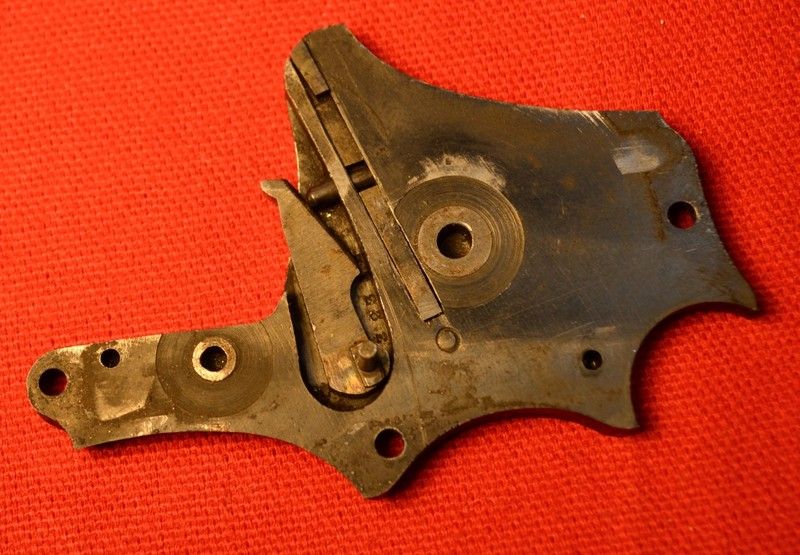
This 38 M&P was made in 1939 and it incorporates the next type of hammer block that S&W installed in their revolvers. This one has less moving parts than the earlier one. The hammer block is one piece of spring steel staked into its slot in the side plate. There is a tab that extends sideways on the hammer block. This time, the hand has a ramp on it. As the hand rises, the ramp pushes the hammer block back into the side plate, allowing the hammer to fall all the way and fire a cartridge.
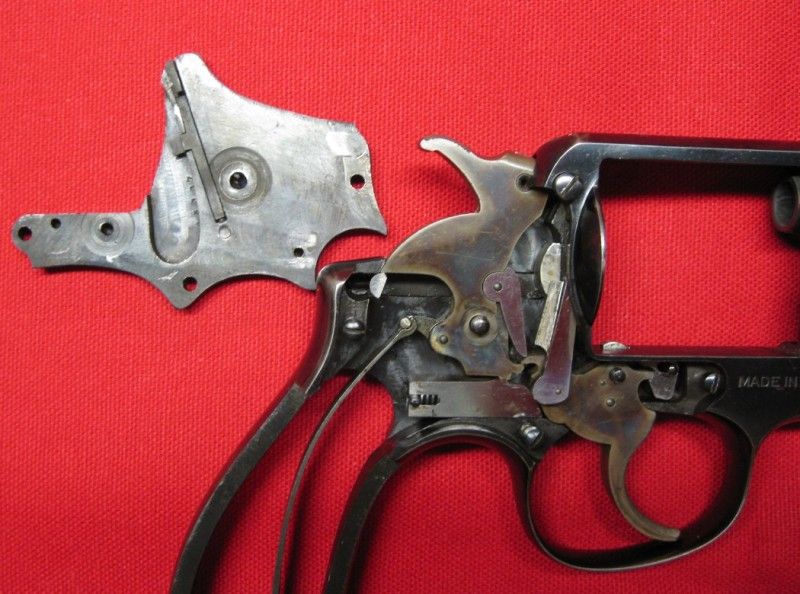
This is the type of hammer block that failed in the case of the sailor killed in 1944. An investigation was held, and it was determined that heavy grease or cosmoline in the mechanism had prevented the hammer block from springing forward to the 'safe' position. So when the gun fell to the deck, something sheared inside and the sailor was killed.
Since this was during WWII, the military demanded that S&W come up with a quick solution if they wanted to maintain their contracts with the government. Extensive tests were run, dropping revolvers from fixed heights, and it was determined that parts were shearing, and the current passive design of the hammer block was inadequate. The engineers were called in, and in one week's time they came up with the new hammer block design that is still incorporated in every Smith & Wesson revolver today.
Notice in this modern (1974) Model 14-3, the rebound slide still has the hump on top, wedging the hammer back from the frame. Notice too how thin the cross section of the hammer is where I drew the line in the earlier photo. This is hammer block that S&W has been installing since 1944. As the trigger moves backwards, in either single action or double action mode, it pushes the rebound slide back. The pin on the rebound slide pulls the hammer block down in its slot in the side plate, freeing the hammer to fall all the way. As the trigger is released, the rebound slide pushes the hammer block back up in its slot, blocking the firing pin from striking the primer of a round under the hammer.
Keep all that in mind the next time you decide to disable 'extra locks/safeties'. Remember how thin the cross section is at the bottom of the hammer, just in case you manage to drop the revolver on its hammer and the barrel is pointing up at you.

Last edited:
hey are full of MIM parts ---
Big Jim, can you elaborate on how which parts on the 627 are MIM, and how you know they are MIM? Just currious because this is a a revolver I'm seriously considering purchasing. Not that these MIM parts are necessarily a problem, I'd just like to know what I'm buying.
I've got several Smith's with the lock and haven't had a problem. Fact is I don't even notice it anymore but truth be told, I'd prefer them without it. As I never sell, the locks affect on resale is a nonissue. (M60, M69, M629, and my wife's M637).
There are a dozen other Smiths here on our farm and I've not had any trouble with them either. LOL
HTH's, Rod
There are a dozen other Smiths here on our farm and I've not had any trouble with them either. LOL
HTH's, Rod
Driftwood Johnson
New member
Big Jim, can you elaborate on how which parts on the 627 are MIM, and how you know they are MIM? Just currious because this is a a revolver I'm seriously considering purchasing. Not that these MIM parts are necessarily a problem, I'd just like to know what I'm buying.
I'm not Big Jim, but perhaps I can answer your question.
According to the Standard Catalog of Smith and Wesson, the MOdel 627 was introduced in 1989. When the Model 627-3 was brought out in 1998, the hammer and trigger were changed to MIM parts. The internal lock was introduced in 2002 with the Model 27-5.
Having taken apart a Model 617-6 that was made in 2003 I can say with fair certainty that the Hammer, Trigger, Cylinder Bolt, Thumb Piece, Rebound Slide and Cylinder Stop are all MIM parts now.
Having taken apart a Model 617-6 that was made in 2003 I can say with fair certainty that the Hammer, Trigger, Cylinder Bolt, Thumb Piece, Rebound Slide and Cylinder Stop are all MIM parts now.
Drift, do you think there is any reason to have concerns about those parts? I haven't heard of any failures, have you?
I am not anti-MIM. Frankly, I believe that if it weren't for MIM, gun manufactures would try to get away using polymer parts wherever they can. Then tell us to "just deal" with the fact that their guns don't hold up to firing more than 3K rounds without a factory overhaul.
Last edited:
Model12Win
Moderator
The MIMs are g2g in a Smith.
They've been used for many a year, and are proven Smith tough. The ILS (Internal Lock System) adds a level of security never before seen in firearm's technology. It is socially and morally reprehensible to NOT desire a lock on Smith revolvers. Also, Smith revolvers of today are some of the best they've EVER MADE. The new advanced technologies such as two-part barrels, MIM, the internal lock, and other new and improved features makes for some of the world's most accurate and reliable revolvers.
BUY ONE. NOW!!!
They've been used for many a year, and are proven Smith tough. The ILS (Internal Lock System) adds a level of security never before seen in firearm's technology. It is socially and morally reprehensible to NOT desire a lock on Smith revolvers. Also, Smith revolvers of today are some of the best they've EVER MADE. The new advanced technologies such as two-part barrels, MIM, the internal lock, and other new and improved features makes for some of the world's most accurate and reliable revolvers.
BUY ONE. NOW!!!
Last edited:
Driftwood Johnson
New member
Drift, do you think there is any reason to have concerns about those parts? I haven't heard of any failures, have you?
No, I have no concerns about MIM parts. The engineers at S&W did a good job when they started designing them, testing the parts to failure mode to be sure they would stand up as required.
I just don't like them. MIM parts are clearly less expensive to produce than traditionally made forged and machined parts. In addition to that, many of the MIM parts in modern S&W revolvers have been re-engineered to be easier to assemble than the old parts. That means the guns can be assembled by workers who do not have the skill level of the assemblers in the past, and that is another way to drive the cost out of producing the guns. You don't have to pay unskilled workers as much as you have to pay skilled workers.
I just like the old fashioned way of making guns, and am not enamored with what S&W is producing today.
If you want a more in depth discussion of the difference between MIM parts and forged and machined parts, you might want to check out the post I put up on The High Road a few years ago.
https://www.thehighroad.org/index.php?threads/comparing-a-s-w-revolver-made-with-mim-parts-to-a-revolver-made-with-machined-parts.769929/
It is socially and morally reprehensible to NOT desire a lock on Smith revolvers.
Oh my. I never thought my desire to collect older S&W revolvers made me "socially and morally reprehensible" - I learn things here every day. I guess I must be part of that "basket of deplorables" as well, right? Isn't it enough that my guns reside in a rather sturdy safe when I'm not using them (except for the one on my hip, that is) - do they really have to have an internal lock, too? Can I regain respectability and return to the path of righteousness if I turn them all in to my local constabulary to be beaten into plowshares?
Driftwood Johnson
New member
I think he was being facetious.
